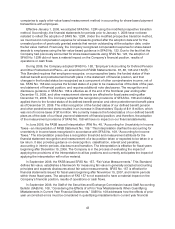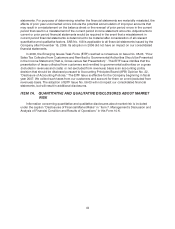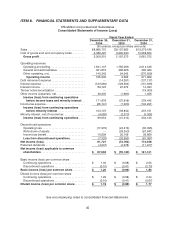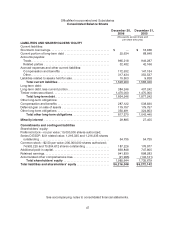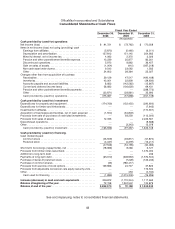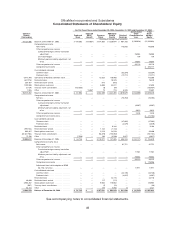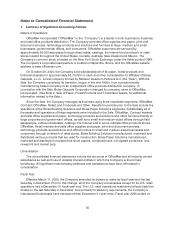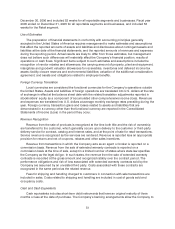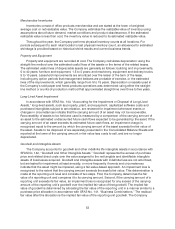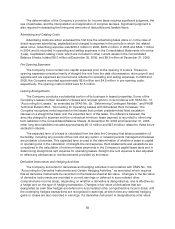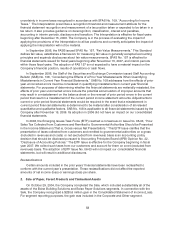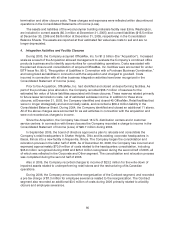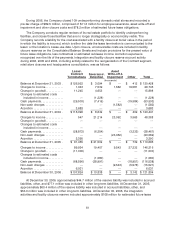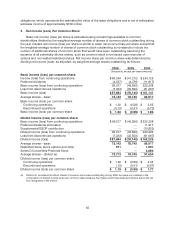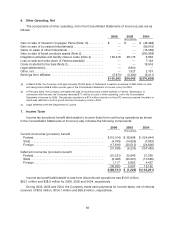OfficeMax 2006 Annual Report Download - page 57
Download and view the complete annual report
Please find page 57 of the 2006 OfficeMax annual report below. You can navigate through the pages in the report by either clicking on the pages listed below, or by using the keyword search tool below to find specific information within the annual report.53
Merchandise Inventories
Inventories consist of office products merchandise and are stated at the lower of weighted
average cost or net realizable value. The Company estimates the realizable value of inventory using
assumptions about future demand, market conditions and product obsolescence. If the estimated
realizable value is less than cost, the inventory value is reduced to its estimated realizable value.
Throughout the year, the Company performs physical inventory counts at all locations.For
periods subsequent to each retail location’s last physical inventory count, an allowancefor estimated
shrinkageis provided based on historical shrinkresults and current business trends.
Property and Equipment
Property and equipment are recorded at cost. The Company calculates depreciation using the
straight-line method over the estimated useful lives ofthe assets or the terms of the related leases.
The estimated useful lives of depreciable assets are generally as follows: building and improvements,
5 to 40 years; furniture and equipment, 1.5 to 5years; and machinery, equipment anddelivery trucks,
5 to 10 years. Leasehold improvements are amortized over the lesser of the term of thelease,
including any option periods that management believesare probable of exercise, or the estimated
lives of the improvements, which generally range from 5 to 15 years. Depreciation on assetsusedin
the Company’s sold paper and forest products operations was determined using either the straight-
line method or a units-of-production method that approximated straight-line over three to five years.
Long-Lived Asset Impairment
In accordance with SFAS No. 144, “Accounting for theImpairment or Disposal of Long-Lived
Assets,” long-lived assets, such as property, plant, and equipment, capitalized software costs and
purchased intangibles subject to amortization, are reviewed for impairment whenever events or
changes in circumstances indicate that the carrying amount of an asset may not be recoverable.
Recoverability of assets to be heldand used is measured by a comparisonof thecarryingamount of
an asset to theestimated undiscounted future cash flows expected to be generated by the asset. If the
carrying amount of an asset exceeds its estimated future cashflows, an impairmentcharge is
recognized equal to theamount by which the carrying amount of the asset exceeds the fair value of
the asset. Assets to be disposed of are separately presentedin the Consolidated Balance Sheets and
reported at the lower of the carrying amount or fair value less costs to sell, and are no longer
depreciated.
Goodwill and Intangible Assets
The Company accounts for goodwill and other indefinitelife intangibleassets in accordance with
SFAS No. 142, “Goodwill and Other Intangible Assets.” Goodwillrepresentsthe excess of purchase
price and related direct costs over the value assigned to the nettangible and identifiable intangible
assets of businesses acquired. Goodwill and intangible assets with indefinite lives are not amortized,
but are tested for impairment at least annually, or more frequently ifeventsand circumstances
indicatethat the asset mightbeimpaired, using a fair-value-based approach. An impairment loss is
recognized to the extentthat the carrying amount exceeds the asset’s fair value. This determination is
made at the reportingunit level and consists of two steps. First, the Company determines the fair
value of a reporting unit and compares it to its carrying amount. Second, if the carrying amount of a
reporting unit exceeds its fair value, an impairment loss is recognizedfor any excess of the carrying
amount ofthe reporting unit’s goodwill over theimplied fair value ofthat goodwill. Theimplied fair
value of goodwill is determined by allocating the fair valueofthe reporting unit in a manner similar to a
purchase price allocation in accordance with SFAS No. 141, “Business Combinations.” The residual
fair value after this allocation is theimplied fair valueof thereporting unit goodwill. The Company


